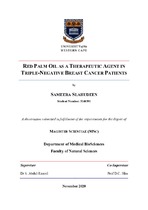| dc.description.abstract | Purpose: Breast cancer is one of the most frequent and fatal diseases women all around the globe are challenged with today. In women, breast cancer has the highest mortality rate of all cancers and the incidence rate is on the increase. It is estimated that by the year 2025, 19.3 million women will become a victim of this grave health problem. This disease is a result of the formation of malignant tumours caused by genetic alterations that are involved in the proliferation of cells, cellular differentiation and the disturbance in homeostasis which subsequently leads to the abnormal multiplication and growth of cells. Breast cancer is considered a multifactorial disease with various risk factors such as age, radiation exposure, hormone therapy, oral contraceptives, dietary factors, environmental exposure and genetic predispositions. Breast cancers can be subdivided and classified based on their cellular surface receptors such as Estrogen Receptors, Progesterone Receptors and Human Epidermal Growth Factor Receptor 2. Of the various subtypes, the triple-negative breast cancer subtype which is negative for all 3 surface receptors and presents as the most aggressive form of breast cancer with a poor prognosis. Between 10-20% of all breast cancer cases are classified as triple-negative breast cancer. Due to the hormonal status of triple-negative breast cancer, treatment options are limited and thus of great concern. Chemotherapy remains the most common treatment modality, but prognosis is poor with relapse within years ultimately leading to poor survival outcome. Due to this lack of effective treatment plans, an alternative treatment with minimal side effects and better survival remains an imperative area to explore. A wide scope of literature highlights red palm oil and its health benefits, with its growth inhibitory potential drawing great attention. Red palm oil, extracted from the Elaeis guineensis palm tree is red in colour due to the abundance of carotenoids, tocotrienols and tocopherols found in the oil. Various compounds make up the oil such as lycopene, carotenes, vitamin E and coenzyme Q10. Most studies have researched the effects of vitamin E extracted from the oil as a contributor to its growth inhibitory activity. This study focuses on the effects of the commercial red palm oil as a whole with all its compounds on the proliferation of breast cancer cells as well as the effect it has on various genes associated with breast cancer. Method: This study investigated the effect of red palm oil concentrations (1, 10, 100, 500 and 1000 μg/ml) on breast cancer cells—MCF-7 and MDA-MB-231 with comparison to a non-cancerous cell line—MCF-12A for 24-, 48- and 72-hour treatment periods. The parameter investigated was cell proliferation through the CCK-8 cell proliferation assay and the morphology following red palm oil treatment was observed and captured. Additionally, this study also investigated the effect of red palm oil on the expression of Human Mammaglobin (hMAM) and Maspin genes through the PCR assay and results visualised through agarose gel electrophoresis. Data was statistically analysed using GraphPad version 6.0 software. Results: Following treatment of red palm oil, no apparent changes in the cell morphology was observed despite using variable treatment concentrations over variable times for MCF-7, MDA-MB-231 and MCF-12A cells relative to their respective controls. Immortalised MCF-12A cells showed a significant increase in proliferation with the varying treatment concentrations, but more prominently with the highest concentration at 24, 48 and 72 hours. MCF-7 cells showed significant decreases at 24 and 72 hours. Decreased proliferation was observed at all dosages used, particularly at 10, 100, and 500 μg/ml. Furthermore, MDA-MB-231 cells demonstrated a gradual increase in cell proliferation for the 3 selected time periods in the varying concentrations. Additionally, red palm oil did not alter the gene expression of Maspin at any of the varying treatments for MDA-MB-231 nor MCF-7 cells. However, changes in hMAM gene expression were observed at treatment concentration of 100 μg/ml in MDA-MB-231 cells that were incubated for 24 and 48 hours. However, the hMAM expression was not affected in treated MCF-7 cells. Conclusion: Red palm oil, as an alternative dietary oil, seems to have potential growth inhibitory properties as demonstrated by the change in the cell proliferation of the MCF-7 cells. Literature show that various individual compounds extracted from red palm oil have anti-proliferative and inhibitory effects on breast cancer cells making them good candidates for therapy. However, this study concludes that red palm oil as a whole component would not be a suitable therapeutic agent for highly aggressive triple-negative breast cancer. | en_US |

